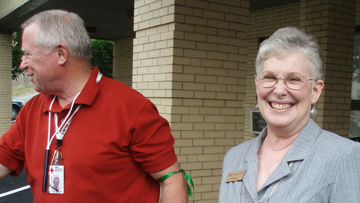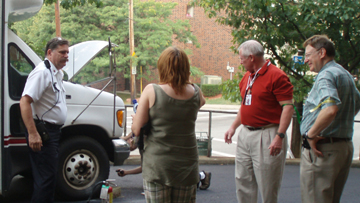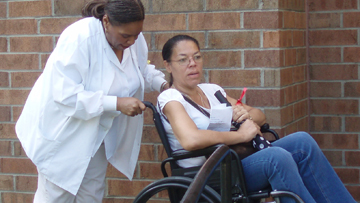
You have free articles remaining this month.
Subscribe to the RP Witness for full access to new articles and the complete archives.
What possesses an administrator of a long-term-care facility to put staff and residents through a full-scale disaster drill that includes an evacuation of the facility?
For me, as administrator of the Reformed Presbyterian Home, it was the stories that came out of New Orleans in the aftermath of Hurricane Katrina. I had many wakeful hours wondering if we could operate safely in a disaster, especially in one that required evacuation. We had written policies and procedures; but I knew from experience that unless the policies and procedures were tested we would never know if they worked.
In 2006, staff from the RP Home attended a disaster preparedness education program provided by Allegheny County Emergency Management System. After the seminar we accepted the offer of the American Red Cross to help us conduct a full-scale disaster drill at the RP Home. I had no idea what I was getting us into!
Grant Wilson, exercise facilitator, and Sandi Wraith, supervisor of emergency services for the American Red Cross, became our guides. For almost a year, the Red Cross and city emergency services personnel met with RP Home staff on a monthly basis designing a drill that would simulate our response to an emergency and would force us to evacuate the Home. Through this exercise, the RP Home staff would assess the adequacy of our Fire and Disaster Policy and Procedure manual, the city of Pittsburgh emergency personnel would gain greater knowledge of our building and its residents, and the American Red Cross volunteers would have practice operating an emergency shelter for persons with special needs.
For our “emergency,” we chose a smoky fire in the electrical equipment room and nearby generator. In this situation, third-floor residents would move to the nursing dining room, and second-floor residents would move to the library, and all would be attended by Home staff. Although the residents would be safe, the Home’s ability to care for them would be compromised because of a complete loss of power. At this point, the administrator and the fire captain would confer and jointly decide to evacuate the building. Residents would be transported to a Red Cross shelter until temporary housing in other nursing homes could be arranged.
A disaster drill is not a simple process, and we had a lot to do before we were ready. Grant and Sandi came to the meetings with a well-developed plan that we followed step by step. We looked at issues such as temporary lodging, acquisition of medications, transportation of med carts, replacement of damaged or destroyed medications, supervision of residents with cognitive and memory deficits, transportation, meals, transfer agreements, and emergency phone trees. Layer by layer, the plan for our disaster drill began to take shape.
Before we knew it, it was Oct. 9 and time for the drill. At 10 a.m., the fire alarm sounded, and Home residents and staff responded appropriately. Residents gathered in safe rooms away from the “fire and smoke” while the local fire battalion responded.
At this point, the drill was halted for 20 minutes so a switch could take place. Residents and care staff returned to their normal activities while their places were taken by role players in anticipation of the evacuation exercise. Red Cross volunteers became residents, replacing all but four residents who participated. Staff members who were not normally scheduled to work at that time played themselves and cared for the evacuating “residents.” Grant and Sandi had told us that we would have fun with the disaster drill. Though I had a hard time believing them, they were right.
Two days after the drill everyone who had played a significant role came back for a debriefing. All of us shared our experiences, and what we had learned from the exercise. We learned that communication with all players was a significant issue. Some communication was very good and some not so good.
We learned to work through glitches—just like in a real disaster. Because of a schedule change at the firehouse, the battalion chief who was prepared to work with us was not on duty. The location of the shelter was changed at the last minute. We had arranged with a sister nursing facility to borrow one of their buses to help with the evacuation, but as the bus arrived its right brake burst into flames!
On the positive side, we gained a realistic picture of how much time is involved in moving residents with special needs; how important it is to foster our relationship with other faith-based facilities when it comes to quickly finding enough beds to transfer residents in a short time; and the importance of the American Red Cross and their shelter team that supported us through this whole endeavor. We found the volunteer residents provided by the Red Cross to be some of the most tenacious actors we have ever encountered. We had to finally beg Sandi to tell them to drop out of character because they truly exhausted us in our efforts to care for them. We learned how very important our pharmacy was in this whole process. They attended most of the planning sessions throughout the year and had significant input into what we should do to maintain the integrity of the medication administration process and provide a secure supply off site.
Staff who were assigned the task of obtaining housing for everyone were able to meet that goal. They called all the facilities on the day of the drill and actually obtained enough beds for each of our residents. In a real situation, we would have been able to transfer all of our residents to an equal or higher level of care.
I cannot say enough in appreciation of the people from the American Red Cross for the hours they spent teaching and working with us to provide this very valuable learning experience. We have developed not only professional relationships but also real personal friendships. “Isn’t it nice that there is an organization that will respond to disasters,” once summed up my view of the role of the American Red Cross. Now I am astounded by the magnitude of the job it does.
This has been a positive experience for us at the Reformed Presbyterian Home. The staff responded to the challenge of a disaster drill with enthusiasm and professionalism. The amount of work involved was tremendous but was well worth the effort.

